
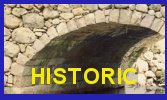
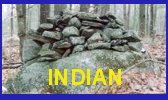
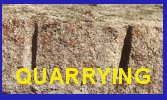
Native American Worked Stone at America’s Stonehenge
By Mary E. Gage
Copyright © 2021
Revised January 2021
Abstract
There is abundant archaeological evidence at the America’s Stonehenge (formerly Mystery Hill) Site that Native Americans quarried, shaped and carved stones. This paper reviews a 1982 excavation conducted by David Stewart-Smith, Ph.D. (professor and master stone mason) which was supervised by Gary Hume Ph.D. who was the New Hampshire State Archaeologist at the time. The excavation uncovered evidence for the use of the percussion method of stone working using stone tools. In addition to the percussion technique, the author has found physical evidence for the use of the pecking, abrading, and fire methods of quarrying, shaping and carving stones. Percussion, pecking and abrading are all techniques well documented as being used by Native Americans to produce lithic tools and projectile points. Examples of stones worked using these different techniques are all found integrated into the stone structures and features found a this site.
Introduction
In 1982, Gary Hume Ph.D., New Hampshire State Archaeologist, supervised an excavation of a large quarried stone at America’s Stonehenge formerly known as Mystery Hill. Hume had the following to say in an interview with the New Hampshire Times (April 25, 1983, pp 20-21), “The bulk of the stones at Mystery Hill were quarried by hand, using stone tools. `The marks are unmistakable,’ says Gary Hume.” During an interview for the local PBS program, New Hampshire Crossroads, Hume made a comment about Native American’s possible usage of the site. He felt the site may have been used for ritual purposes such as the Native American “vision quest.” (Stewart-Smith, 1989: 8, 10-11)
The interview excerpt was quoted in David Stewart-Smith’s monograph Ancient and Modern Quarry Techniques. Stewart-Smith was a Master Stonemason and had a Ph.D. in Interdisciplinary Studies consisting of archaeology, anthropology and history. He had this to say: “The entire site at Mystery Hill indicates an admirable expertise with stone, from quarrying to building. I am, therefore, inclined to say that we have witnessed the remains of indigenous stone masonry techniques unique to Mystery Hill.” (Stewart-Smith, 1989: 10) The only indigenous cultures in New England are the Native Americans.
Both Hume and Stewart-Smith agree the Native Americans quarried stone on Mystery Hill. How extensive was the Native American quarrying? David Stewart-Smith and W.E. Hinton Jr. compiled a map of the stone walls surrounding the central site upon which they indicate all of the stones they had identified as being quarried. The map shows most of the standing stones in the wall (both upright and fallen) were worked by Native Americans. (Stewart-Smith, 1989: 8) Stewart-Smith also stated, “Several stones in the central site have been quarried and dressed in this manner [percussion method].” Stewart-Smith’s research indicates the quarrying activity was quite extensive.
Stewart-Smith’s research focused on the percussion method of stone working at the site. In addition to the percussion method, there is archaeological evidence for three additional stone working methods: pecking method, fire method, and abrading method. This article reviews the evidence for these four stone working methods. Plus, it examines what the methods were applied to.
Methods and Applications
Percussion Method used to Quarry Large Stones
A large quarried stone was found north of the central site. (fig.1) It was excavated by David Stewart-Smith and Joseph Auciello under the supervision of Gary Hume, the New Hampshire State Archaeologist at the time. According to the excavation report in Ancient and Modern Quarry Techniques, the quarried stone measured 13 feet long, 5 feet wide, 1 foot high and weighed approximately 4 tons. It was moved 10 inches and propped up 9 inches with a rectangular granite block. (fig.2) One large concoidal flake and hundreds of smaller “dressing flakes” were removed from the underside face. The flakes were removed from the face to create a flat surface. The stone was then shaped to a point. Stewart-Smith concluded that, “The quarrying and dressing of the stone was carried out using percussion techniques. This form of dressing and hewing is in evidence throughout the site. The peripheral stones are shaped in this manner and several of the roof slabs and uprights within the central site have also been quarried and shaped in this manner. The technique is consistent with indigenous stone working techniques …” (Stewart-Smith, 1989: 4-5) Based upon his experience as a master stonemason, Stewart-Smith was of the opinion that, “… whoever worked this stone showed a confirmed knowledge of quarrying, dressing, and hewing with percussion and passive techniques. The work here is not random or haphazard, nor is it the work of someone ‘making do’ with stone implements. The work was carried out by an expert with stone tools.”(Ibid, 6)
The quarried stone was abandoned before it was finished. The purpose of the stone is unknown. However, an example of a similar tall stone with a pointed top and flat surface can be seen in the area with the Grooved Stone. It leans against the Ramp’s front wall and is shown in a photograph (fig.3) with William Goodwin standing beside the Grooved Stone in his book The Ruins of Great Ireland in New England (1946).
 |
Figure 1 – Native American quarried slab excavated and examined by David Stewart-Smith

Figure 2 – The quarried slab was raised up by a rectangular stone block
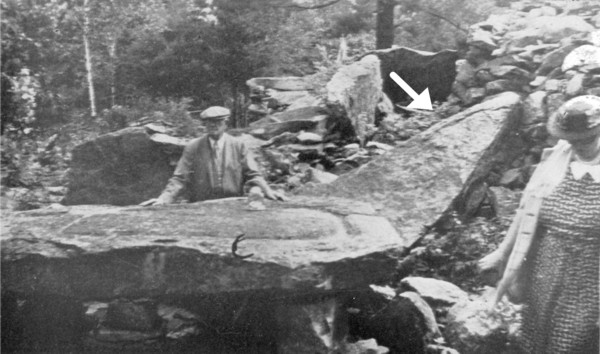 |
Figure 3 – Photograph by Malcolm Pearson showing William Goodwin next to the Grooved Stone. The white arrow points to a large pointed worked standing stone similar to the one excavated by Dr. David Stewart-Smith.
(Goodwin 1946, 83)
Stewart-Smith’s work shows Native Americans were experts at quarrying large stones, had the expertise to move these large stones and to build structures with the large stones they had quarried. He specifically noted that some of these quarried stones were used as “roof slabs [in the stone chambers] and uprights within the central site.”
Percussion Method used to Shape Small Portable Stones
Stewart-Smith’s research focused on the use of the percussion method to shape large stones. The technique was also used to shape smaller Native American tools and artifacts. In the America’s Stonehenge visitor’s center, the artifact showcase has a stone slab about 12 inches tall. The shape is similar to a flat shovel blade with a very short handle. Around the whole outer edge are flake marks showing the percussion technique was used to shape this stone artifact (fig.4). A member of William Goodwin’s crew found the stone shovel on site (Feldman, 1977: 35). James P. Whittall, Jr. found several more examples of stone shovels (fig.5). During an excavation behind the Collapsed Chamber, he recovered, “Broken stone picks, a hammer-stone and a stone hand shovel. The shovel has matching, pecked shallow side-notching for handholds and the working edge has wear-polish.” (Reported in Glynn, 1967: 56) During an excavation at the Watch House Chamber, Whittall uncovered, “an excellent stone hoe eleven inches long.” He was uncertain whether the stone implement was a shovel or hoe. (Whittall, 1969a: 80) In 1970, Whittall published a photograph of some artifacts from the site. (Whittall, 1970: 84) Artifact #9 is an exact match to Goodwin’s shovel with one exception. The shovel Whittall found appears to have a semi-worn bottom whereas the example Goodwin found was fresh with crisp flake marks on the bottom. Keith Wilbur in his book The New England Indians (1978) illustrated a similarly shaped stone shovel used to shovel stone fragments into a basket for removal at a soapstone quarry (p.14).
Also in the visitor center showcase are two Native American pendants. One is a small bone pendant with a drilled hole (fig.6). The second is a small rectangular shaped stone with a short top knob and a long slanted side. It also has a drilled hole. In a conversation (personal communication February 2010), Dennis Stone (owner of the site) told the author the pendants were found on site but did not say where.
The stone pendant has a shape similar to the Summer Solstice Sunrise alignment stone (fig. 16). These two similarly shaped stones form a pattern. A similar type of pattern was found with the two sunset alignment stones. The Winter Solstice Sunset alignment stone has a peak with two sloping shoulders. The Summer Solstice Sunset alignment stone has a peak with two rounded shoulders. What this shows is the two confirmed sunset stones each have a similar basic shape: a peak between two shoulders. So it is not surprising to see a pendant with a similar shape to another stone on the premises. These patterns are not by coincidence as Stewart-Smith pointed out. He noted on his map all of the perimeter standing stones including the alignment stones were shaped by the Native American stone masons (Stewart-Smith, 1989: 8-9). The stone pendant adds another piece of evidence supporting that conclusion. Furthermore, pendants in general are associated with ceremonialism in the Native American culture.
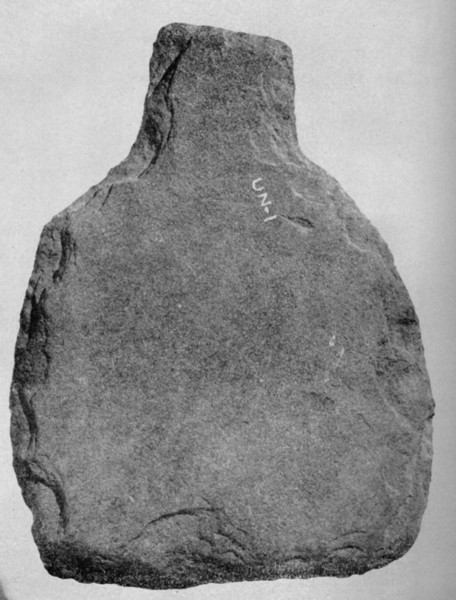 |
Figure 4 – Stone “shovel” artifact found by William Goodwin’s crew and now currently on display at the visitors center. Photograph by Malcolm Pearson. (Goodwin 1946, 420)
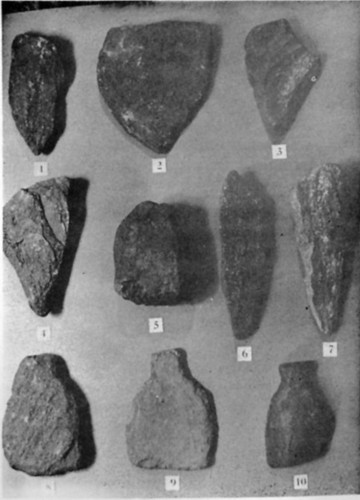 |
Figure 5 – Artifacts excavated by James Whittall Jr. Artifact #9 is similar to the stone “shovel” found by Goodwin except it has a semi-worn bottom whereas the example Goodwin found is fresh with crisp flake marks on the bottom.
(Whittall 1970, 84)
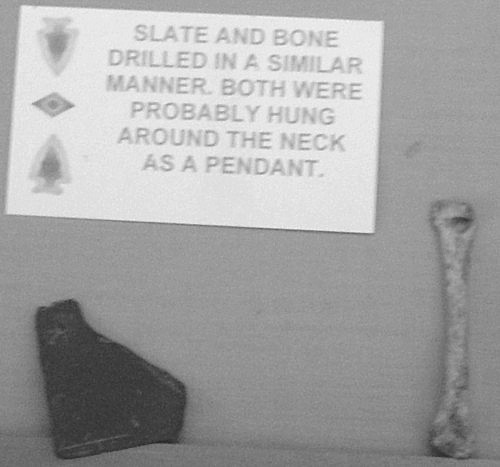 |
Figure 6 – Native American stone and bone pendants found at America’s Stonehenge.
Fire Method
George Quimby, a Professor of Anthropology and expert on Great Lakes Native Americans, stated that the Native American, “method of mining was as follows. The Indian miners followed the veins of pure copper from surface outcrops by digging pits and breaking the copper from its rock matrix with the aid of fire and water and large beach boulders used as hammers.” (Quimby, 1971: 52)
Two excavations conducted by James Whittall, Jr. yielded charcoal and evidence of stone quarrying in the central part of the site. There was evidence that fire was used as part of the quarrying process.
Excavation Number 1
In May of 1969, Whittall excavated a trench next to the exterior north wall of the Collapsed Chamber unit. Between 3 inches and 8 inches above bedrock, “numerous sharp-edged spalls from granite quarrying,” and “charcoal flecks occurred” plus “a broken [stone] pick, a hammerstone, and a handscraper” were found. “Some of these [sharp-edged spalls] showed evidence of fire. The scraper showed wear on the working edge. A sample of charcoal picked from this level was submitted to Geochron Laboratories for Radiocarbon 14 testing. We obtained a dating of 2995 years B.P. +/- 180.” (GX-1608) (Whittall, 1969: 50)
Excavation Number 2
In October 1970, an excavation took place next to the 75 foot long ditch drain laid out on level ground on top of the hill. “This particular area was chosen for excavation because a soil probe indicated charcoal in a lower soil horizon. Excavation revealed charcoal on top and in a seam of quarried bedrock. This was located 23 inches below ground level in a leached yellow soil profile. Test conducted by GEOCHRON LABAORATORIES (Sample No. GX-2029) resulted in a radiocarbon C-14 date of 2120 +/- 95 years B.P.” (Whittall, 1971: 19)
The charcoal from the 2995 B.P. C-14 date was mixed in with sharp-edged stone spalls (some of which had evidence of fire) and stone quarrying tools. The charcoal from the 2120 B.P. C-14 date was taken from bedrock in which a stone slab was quarried and removed. This evidence suggests that fire was used as part of the quarrying process.
Pecking Method
The pecking method was used to create a number of archaeological features at the site. A representative sample of these features will be discussed. The pecking method uses a hammer stone or stone pick to repeatedly hit the surface of another stone to fracture away small pieces of the surface. This results in the creation of small closely spaced depressions. The depressions can be any shape and depth depending on the amount of force applied and the hardness of the stone.
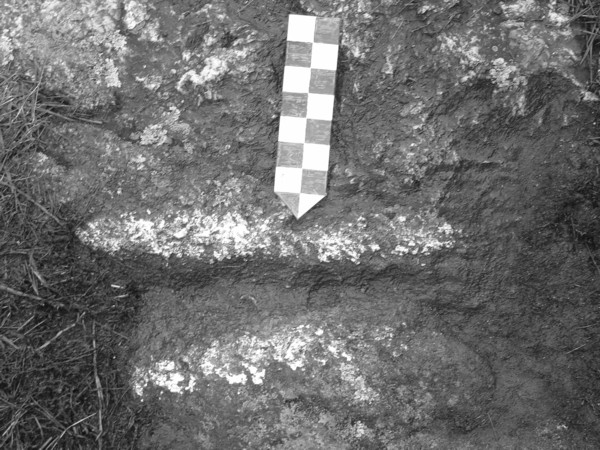 |
Figure 7 – A short pecked groove near the Mensal Stone chamber.
Short Grooved Drain in Bedrock (Fig. 7)
There is a short roughly pecked straight groove in the bedrock next to the Mensal Stone Chamber. It is oriented north to south towards the end wall of the chamber.
Groove: 12” long x 2” to 3” wide.
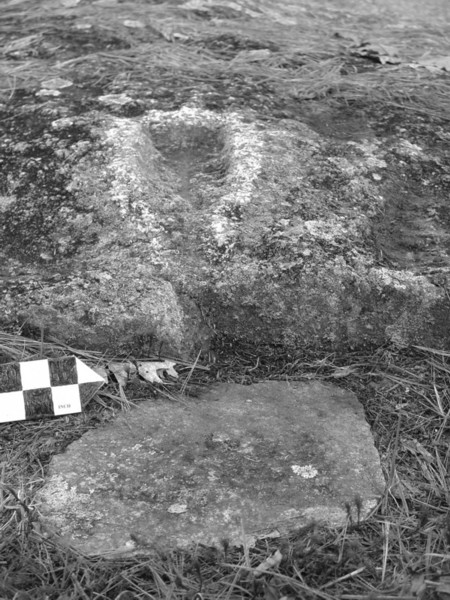 |
Figure 8 – A pecked groove was carved into the bottom of a pecked rectangular depression. The groove extends to the edge of the stone slab. A flat stone was placed below the exit point of the groove.
Waterfall Drain (Fig. 8)
The grooved drain feature has a straight pecked groove placed down the center of a pecked rectangular depression. It is located on top of a capstone over a covered drain. The rectangular depression has a squared-off end on its east side. On the opposite west side the depression narrows as it connects with an L shaped corner on the edge of the capstone. The drain down the center of the depression exits at the L shaped corner. Three inches below the exit point is a stone plate. Water poured into the drain exits at the edge and cascades over the edge forming a small waterfall.
Groove: 15” long
Rectangular Depression: 15” long by 4½” wide x 1” deep
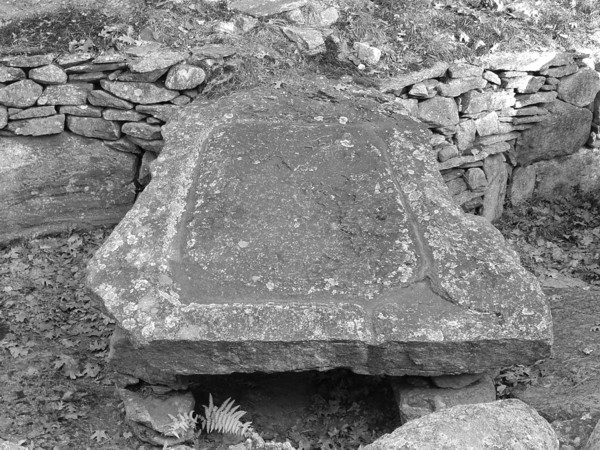 |
Figure 9 – The Grooved Stone rests on four stacked stone columns and the edge of the Oracle Chamber. It is in its original unaltered position.
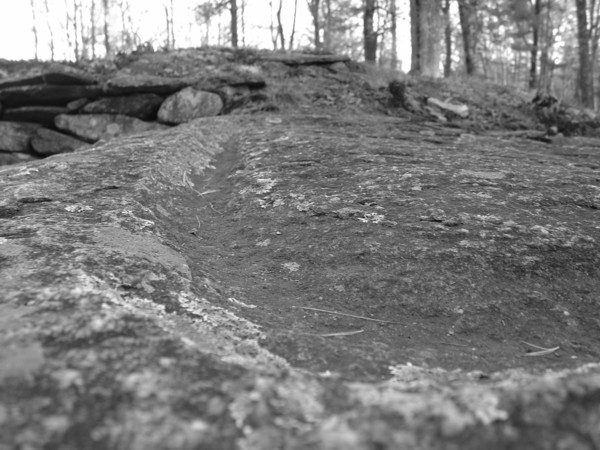 |
Figure 10 – Close-up showing the pecked perimeter groove on the Grooved Stone.
Grooved Stone (Fig. 9 & 10)
The large grooved stone has been the subject of much controversy including claims that Goodwin may have altered it in some manner. William Goodwin clearly states in his book The Ruins of Great Ireland in New England, “Until that last summer we had always presumed that the great Sacrificial Stone was lying on the slope of the Y cavern mound. So we removed all the fine particled humus from beneath this flat table and sifted it. To our astonishment, however, we found that the stone did not rest on the ground for support but on four low pillars of sectional stone legs directly on level bedrock! What is more amazing is that underneath that sacrificial stone and hidden at the back of it, was the outside mouth of the 5” x 5” square passage through the thick stone walls of the Y cavern …” (Goodwin 1946, 203-4) Goodwin’s statement shows the Grooved Stone is in situ and that it was set up above the speaking tube in the Oracle Chamber.
The stone slab has a rectangular shape overall. On its west end it flares out on either side and on its east end it narrows slightly. The exposed front edge of the west end is flat. The slab was raised off the bedrock on four stone columns. Its east end extends out so it rests on the exterior top of the Oracle Chamber. A wide shallow pecked groove with flared out sides goes around the complete inner perimeter of the stone slab. A short, narrow, shallow pecked groove on the west end creates a channel from the perimeter groove out to the edge of the stone slab. Below the short groove, called the spout, is an L shaped cutout in the bedrock.
Stone Slab: 8’ 5” long x 6’ 3” wide x 10” thick (average)
Height off bedrock 2’ 6” on west end and 2’ 11” on east end
(As measured to the top of slab)
Perimeter Groove: Layout is approximately 4’ 2” wide x 6’ long (overall)
Width of the groove varies from 2” to 5”
Depth of the groove varies from 1” to 1 ½”
Short Groove: (Spout) 10” long x 3” wide
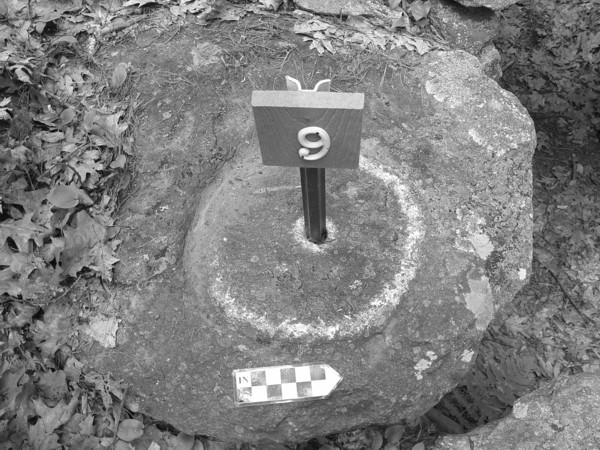 |
Figure 11 – A roughly pecked stone circle in a stone slab which was quarried and shaped using the percussion method.
Grooved Circle Feature (Fig. 11)
A stone slab with a crudely pecked circle with a post hole in the center was found on top of the southeastern end of the Sunken Courtyard unit. The groove is a full circle. It has a rough pecked surface. The edge of the stone slab has several large flakes removed by percussion method.
Grooved Circle: 16½” diameter to outside of circle, width of groove averages 1½”
Abraded Method
Several man-made features at the site have evidence of the abrading method. This method involves pecking out the broad shape and then abrading (grinding) the surface of the stone with another smaller stone (Wilbur, 1978, 14). It generally results in a smooth surface.
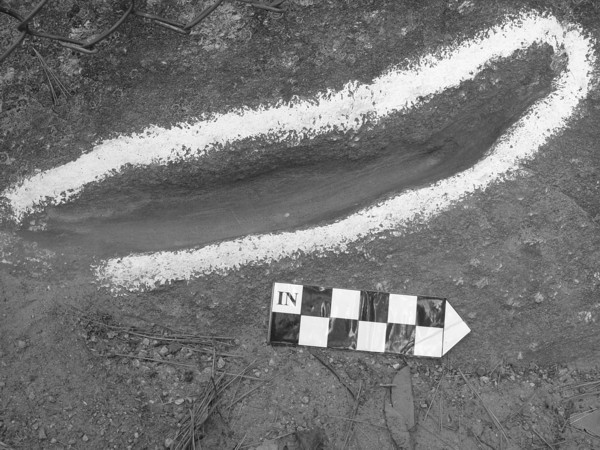 |
Figure 12 – Crescent shaped groove which was smoothed using the abrading method.
Crescent Shaped Grooved Drain (Fig. 12)
A deep crescent shaped groove was found in a stone slab at the Sunken Courtyard. At one edge there is a natural rough depression to which the groove is integrated. Several cone shaped indentations deeper than the bottom of groove were found along the length of the groove. The indentations appear to be guides for the layout and depth. The groove has a few rough spots indicating it may have been pecked out and then abraded smooth. The deepest section is in the middle and the depth lessens as it comes towards the other edge, the drain’s exit point. The stone slab with the grooved drain is a capstone (roof stone) for an unfinished chamber room.
Stone slab: 7’ long x 2’ 9” wide x 6” thick
Groove: 3’ 2” long x 2” wide x variable depths – ½”, 2”, 2¾”
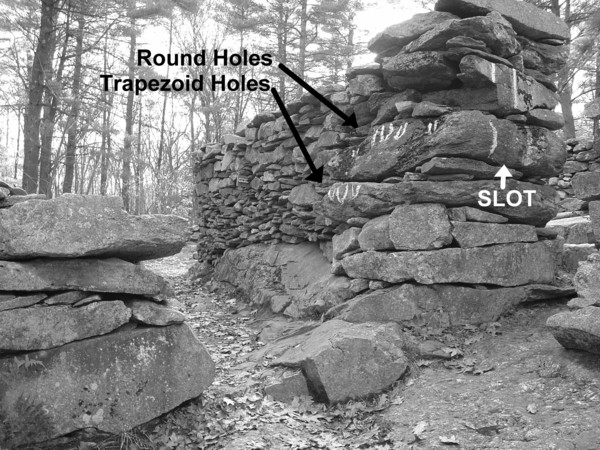 |
Figure 13 – The north end of the Tall Wall structure showing the abraded slot. The quarry marks from a 19th century operation to remove stone slabs from the site are visible on the east side.
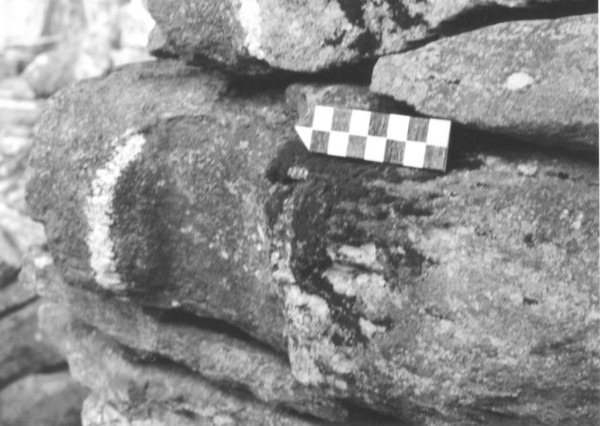 |
Figure 14 – A close-up photograph of the abraded slot.
Abraded Slot (Fig. 11)
On the north end of the Tall Wall structure there is a stone slab with a shallow abraded vertical slot on its north face. On the top edge of its eastern face there are a series of five 19th century quarry drill marks. It is known that Goodwin’s crew rebuilt portions of this wall. Was this slab part of the reconstruction?
Is the stone slab oriented correctly? The stone slab is rectangular and measures 5 feet 5 inches long by 4 feet 5 inches wide. The wall is about 4 feet 5 inches wide. If the slab was rotated 90 degrees from its current position it would protrude about 12 inches out from the end of the wall. If it was rotated 180 degrees (i.e. turned around) the abraded slot would be inside the wall and not visible. The 19th century quarry marks are on the top edge of the slab where one would expect them to be. The slab is correctly oriented within the wall.
Was it repositioned? The stone slab was split using drilled round holes (i.e. plug and feather method of splitting which date from 1820 AD to present). The stone slab below it was also quarried but with a different technique. The lower slab has trapezoid shape quarry marks created by a cape chisel (i.e. flat wedge method which dates from 1800 AD to circa 1870). The reason the workmen switched techniques was because they wanted to split the lower slab as close to the edge of the upper slab as possible. It was too difficult to get this close (within an inch or so) and still properly rotate a plug drill with one’s hand around the drill. The cape chisel uses a back and forth cutting method rather than a rotational method. This allowed them to cut the holes by holding one side of the cape chisel with their hand and having the other side close to the side of the upper slab. The two slabs still retain this slightly offset position with the lower slab jutting out an inch or so. It is highly unlikely that Goodwin’s crew would have repositioned these two slabs in this manner. His crew would have positioned them vertically one directly over the other creating a flat face rather than having the lower one jut out. It is reasonable to conclude the stone slab with the slot is in its originally unaltered position. In contrast, the stone slab above the slot juts out slightly blocking the top of the slot. It is clear that this stone and the section of wall above it were rebuilt by Goodwin’s crew in the 1930’s. The damage to the upper section of wall above the slabs was most likely the result of the 19th century workmen preparing to remove the slabs.
Why did the workmen abandon the quarried slabs in the wall? To answer this question requires evaluating the 19th century quarrying evidence. The half round holes are 1 inch in diameter by 3 to 6 inches deep. The depth varied widely and the spacing also varied unevenly. Stone quarried by professional masons had holes spaced evenly across the whole length every 6 to 7 inches and drilled to a uniform depth usually 3 or 4 inches deep. Under this slab is a second large slab with the trapezoid shaped holes. There are three fairly uniform holes spaced appropriately 3 to 4 inches apart in the middle of the slab. The proper way to split a slab that is over 5 feet long using trapezoid shaped holes was to place holes every 4 inches across the whole length. The poor workmanship shows the men who removed some of the stone from the hill did not have any real knowledge or experience with stone quarrying.
The surface bedrock of Mystery Hill is poor quality granite. It does not split well and cannot support a lot of weight without cracking. Mid-19th century commercial quarries routinely blasted this type of poor quality surface granite away to get at the better quality stone deeper in the bedrock. It is clear the workmen removed the split off portions of the stone slabs from the site and possibly one or two more. The quarrying operation ceased after this removal indicating they failed to find a buyer for their junk rock. Failing to find a buyer, they never returned for the other two pieces embedded in the wall.
A solid case can be made that the slot is in its original position. This would suggest it was therefore an integral part of the Tall Wall’s original construction and design. Stewart-Smith had noted in his report that some of the roof slabs in the stone chambers were quarried using the percussion method. This abraded slot once again raises the question as to whether some of these structures may have been built by Native Americans.
Stone slab with slot: 11” thick x 5’ 5” long x 4’ 5” wide
Height to bottom of slab above bedrock: 3’ 6”
Slot: 11” high x 8” wide x 2½” deep
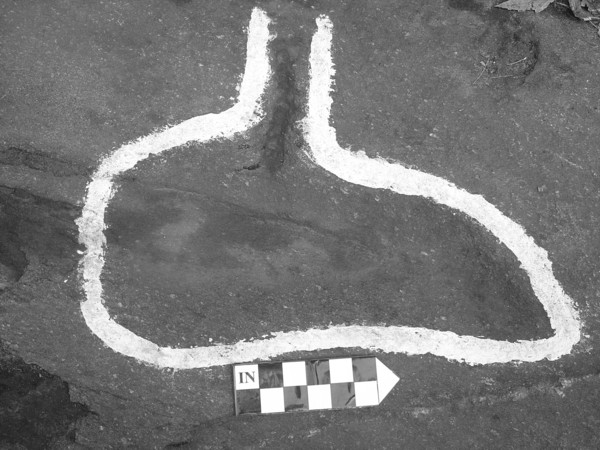 |
Figure 15 – An abraded basin and pecked groove feature.
Basin in Bedrock (Fig. 15)
A basin was pecked into the bedrock beside the exterior wall of the enclosure (filled with refuse from excavations) that is attached to the Collapsed Chamber. It has a teardrop shape which was smoothed by rubbing (abraded). A rust colored quartz vein curves around the south end. Perpendicular to the basin is a pecked groove feature. It has a rough finish in comparison to the smoother finish of the basin. A protruding ridge in the bedrock separates the two features. Neither the basin nor the groove has an exit point. Any liquid such as water poured into either was contained within the feature. This is different from some of the other grooved features in which the water exits the feature like a drain. The two features are paired together.
Basin: 20” long x 8” wide (north end) 5” wide (south end) x 2” deep
Groove: 7” long x 1½” wide x 5/8” deep
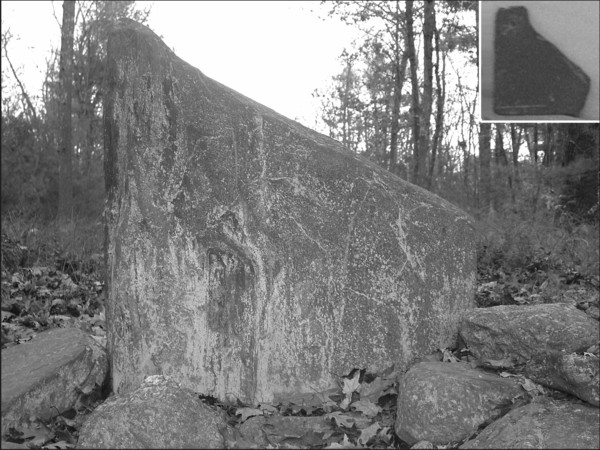 |
Figure 16 – The summer solstice sunrise standing stone. The edges and surface were abraded. Insert: Native American stone pendant similar in shape to the standing stone.
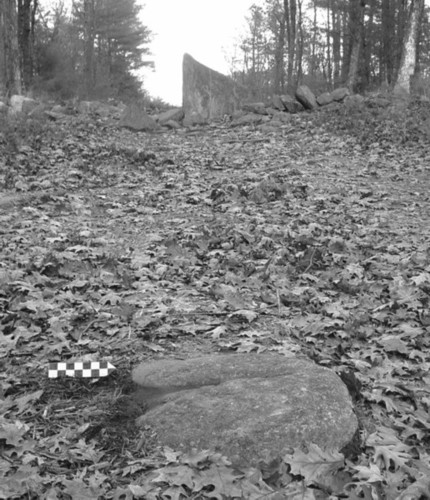 |
Figure 17 – In the foreground is a pecked groove and basin feature 35 feet away from the summer solstice sunrise standing stone. This feature is the optimum viewing position for observing the sunrise over the lower top corner of the standing stone on the solstice.
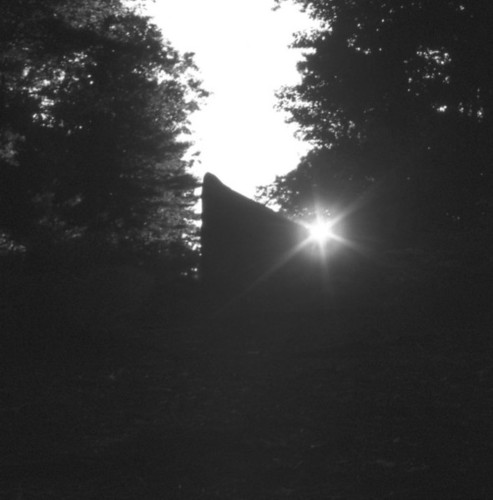 |
Figure 18 – Summer solstice sunrise as viewed from basin & groove feature.
Standing Stone (figs. 16, 17, 18)
In the east side perimeter stone wall there is a standing stone that stands out due to its smooth surfaces. It is the Summer solstice sunrise alignment stone. The stone measures 3 feet 10 inches on the tall north side, 2 feet on the short south side, and 3 feet 6 inches wide. The tall side comes to a pointed knob. It slopes downward from the knob to the short side. After this stone was quarried and shaped, its surface and edges were abraded to a smooth finish.
Thirty five feet west of the summer solstice sunrise alignment stone there is a stone embedded in the ground. A straight groove and crescent shaped basin (full shape unknown, it has not been excavated) were pecked into this in-ground boulder at surface level. The groove starts out narrow and widens out where it connects with the basin. The drain is 15 inches long, the width starts out as ½ inch wide and widens to 3 inches as it connects with the basin.
The position and short distance of the drain feature to the summer solstice standing stone suggested that the two may be related. The author conducted a series of observations on the morning of the summer solstice. At sunrise she sat at the grooved drain and basin. Approximately a half hour after sunrise, the sun’s disk began to appear over the lower corner of the sunrise alignment stone. The sun’s full disk rose directly over the lower corner in a precise manner. This was observed with the naked eye. The grooved drain proved to be the optimum viewing point of this alignment. It was tested for several years with the same results.
Discussion of the Small Basins and Grooved Features
The short 12 inch long straight drain (near the Mensal Stone Chamber) is too short and too shallow to effectively drain much water. It would be easily overwhelmed in a rain storm. The waterfall drain is not much longer at 15 inches. Its drop off is 3 inches high. The short height of the drop off prevents this drain from having a useful utilitarian purpose. The basin feature can hold less than a quart of water. What was the purpose of these three features? Hume felt the Native Americans may have used the site for ritual or ceremonial purposes. These are Native American created features. Is it possible they have some kind of Native American ritual or ceremonial purpose? Is there anything in the historical records to support this hypothesis?
In the 1920’s Gladys Tantaquideon, a Connecticut Mohegan went in search of her Native American customs. This led her to Mashpee where she met elder Eben Queppish, a basket maker. “Eben had the ash splints and said that he would come to the home where I was boarding. So in a few days Eben appeared, and I [Gladys] began my lessons in making a special type of basket. He explained that Little People lived in the woods and along the beaches and that in early times it was customary for groups going out to gather food plants, herbs for medicine, fishing, or hunting, to put some corn bread and meat in a small basket and leave it for the Little People. He added, ‘That was for good luck.’ He was a conservative and lamented the fact that so much of the early culture of our people in southern New England had disappeared.” (Fawcett, 2000: 84-85) The offering baskets are an old custom used to make small food offerings to the Little People. Is it possible the small drains and basins were some kind of offering feature that used water as an offering instead of food or tobacco which is common today?
Conclusion
Gary Hume confirmed Native Americans quarried large stones on site. David Stewart-Smith’s report argues that in addition to quarrying the stones, they set them up in upright positions in stone walls around the perimeter of the site and used them to roof stone chambers. He concluded that they were expert stonemasons and builders. James Whittall, Jr.’s excavations show the Native Americans were quarrying stone as early as the Early Ceramic / Woodland period circa 3,000 years ago. A second C-14 date places the Native Americans at the site quarrying stone circa 2100 years ago.
There is evidence which indicates the Native Americans did more than quarry large stones using the percussion method. They made stone shovel like tools using the same percussion method as used to quarry the large stones. Furthermore, there is evidence that other stone quarrying and shaping methods like fire, pecking, and abrading were also employed at the site. Pecking and abrading were used to create small short grooves and basins carved into the bedrock and into stone slabs. These features have no obvious utilitarian function and may be ceremonial offering features similar to the Masphee offering baskets. The stone pendant carved in the shape of the summer solstice sunrise alignment stone demonstrates a potential direct link between a Native American artifact and one of the quarried stones on the site. Field observations confirm that a pecked groove feature was the most probable viewing position for the summer solstice sunrise.
The pendants and stone shovel like artifacts are a few of the many Native American cultural items unearthed at Mystery Hill. The stones quarried and shaped using the percussion, fire, pecking, and abrading methods attest to the fact the Native American activities at the site went far beyond a mere hunting camp. The map in Stewart-Smith’s monograph shows dozens of worked stones throughout the hilltop complex. The working of a great many stones represented a large investment of time and resources. Such an investment of resources indicates this activity was purposeful. Was it for the construction of solar alignments, stone chambers, and other enigmatic stone structures? There are several lines of evidence that suggest there is a link between the stone quarrying activities and some of the stone structures. A far more detailed study by qualified experts is needed to establish the full extent of how many of the stones used in the structures were quarried using Native American stone working techniques. As for the purpose of these activities, Hume’s hypothesis that Mystery Hill was potentially a place for Native American ceremonies is intriguing and deserves further consideration.
Diagnostic Tool
The evaluation of the percussion, pecking, abrading, and fire methods used to quarry and shape stones at the America’s Stonehenge site has proven a valuable tool for analyzing the archaeological features at this site. It has opened a new line of scientific and archaeological inquiry into the site’s origins. This type of analysis could provide a new scientifically based diagnostic tool for evaluating stone slabs used for chamber roof stones and standing stones found at other controversial stone structure sites throughout northeastern United States.
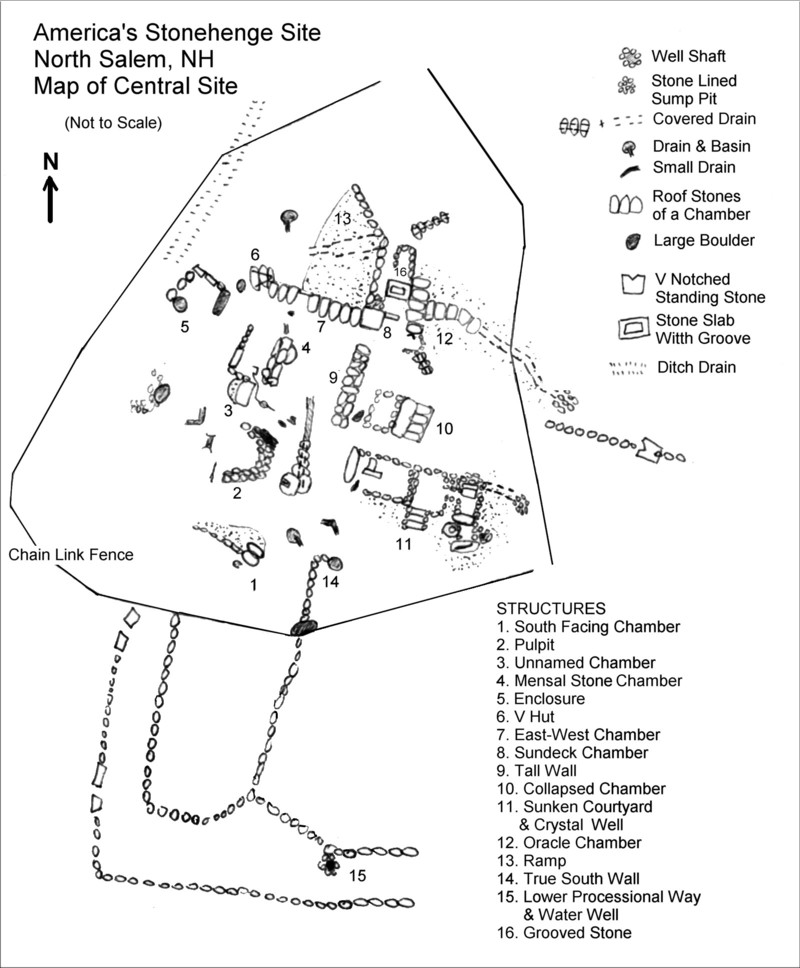 |
Bibliography
Feldman, Mark
1977 The Mystery Hill Story. North Salem, NH: Mystery Hill Press.
Fawcett, Melissa Jayne
2000 Medicine Trail: The Life and Lessons of Gladys Tantaquidgeon. Tucson: The University of Arizona Press.
Glynn, Frank
1967 “1966-67 Excavations at Mystery Hill.” NEARA Newsletter 2(4): 55-57.
Goodwin, William B.
1946 The Ruins of Great Ireland in New England. Boston: Meador Publishing Company.
Quimby, George
1971 Indian life in the Upper Great Lakes 11,000 B.C. to A.D. 1800. Chicago: University of Chicago Press.
Stewart-Smith, David
1989 Ancient and Modern Quarry Techniques. Nashua, NH: Gamemasters Publishers Assn.
Whittall, James II
1969 “2995 B.P. +/- 180.” NEARA Newsletter 4(3): 50-54.
1969a “Mystery Hill Excavations 1969.” NEARA Newsletter 4(4): 80-81.
1970 “Quarrying Tools at Mystery Hill.” NEARA Newsletter 5(4): 81.
1971 “Megalithic Site – Mystery Hill North Salem New Hampshire Radiocarbon Date Excavation October 1970.” NEARA Newsletter 6(1):19-20.
Wilbur, C. Keith
1978 The New England Indians. Chester, CT: The Globe Pequot Press.
